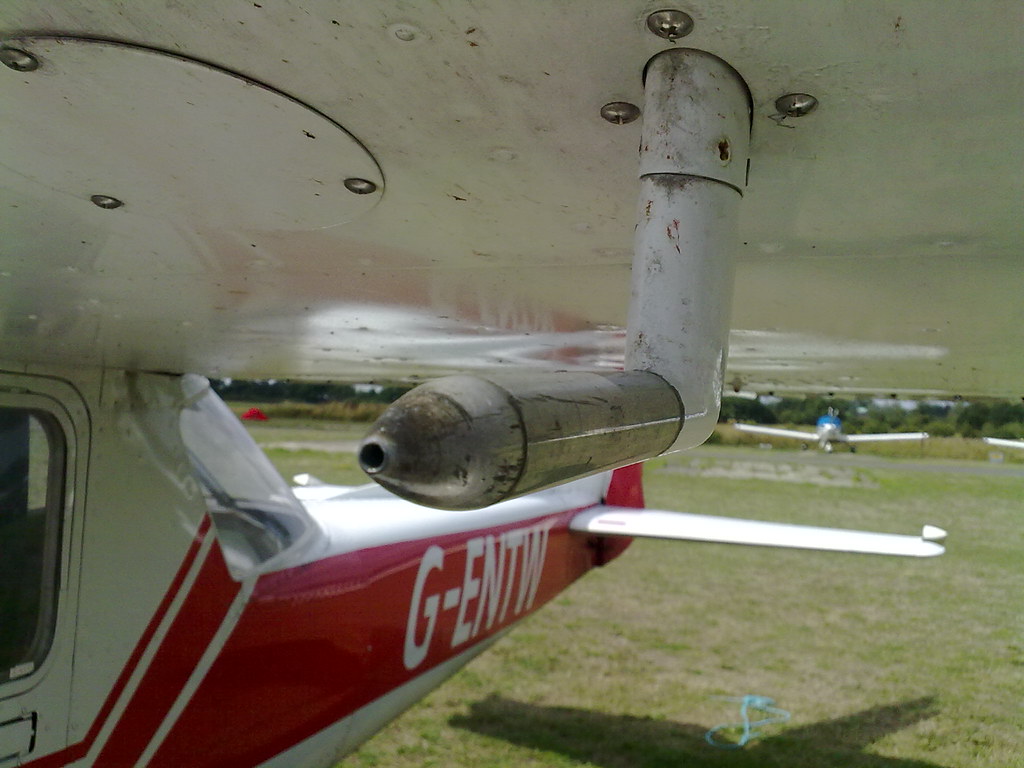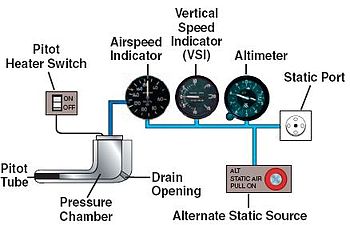

The pitot tube is usually found under the wing in a light aircraft, in the direct airflow of the aircraft moving through the air. It is usually off-set from the wing so that it is not influenced by the shape of the wing, and measures the actual air flow velocity.
The air enters the tube but stagnates as it has no way out. The total pressure is measured, The ASI relies directly on the pitot as well as the static source in order for it to make a comparison between the two sources and provide a reading of the indicated airspeed.
The static source is usually found on either side of the aircraft fuselage (duplicated in order to counter the effects of airflow during yawing and side slipping). It is a clean metal plate with a hole/s to allow for the measurement of the pressure of air that is undisturbed, and not moving. The vent plates are not painted, as this would affect the effect of temperature on pressure readings. The side of the fuselage provides a suitable location as it does not face the direct airflow, and therefore does not experience the dynamic movement of air.
As mentioned previously the ASI needs to be fed both pitot and static pressure in order to provide a reading, however, the VSI and the altimeter are entirely dependent on the static source to provide a reading. For redundancy, some aircraft provide an ‘alternate’ static source in the aircraft in the case of blockage, however, on other aircraft the only option is to break the VSI (least important of the pressure instruments) glass in order to obtain access to the cabin air pressure, The reading is somewhat inaccurate, but at least better than no reading at all!
So, how would you know if your pitot or static source is blocked? To start off with, it is essential to check that both the pitot and static sources are clean and clear. On the ground, possible things that might get in there include insects or dirt. Even if you stop somewhere just for a short while it is always a good idea to put the pitot cover on.
In the air, we are faced with an additional threat that could cause a blockage – icing. But how would we recognise that a blockage has occurred, and is it the pitot, static or both?
The most obvious sign is that one, or all three of these instruments start to misbehave. Understanding the system will help you discern not only the cause, but also possible solutions. Let’s see what happens…
ASI – If you see that your airspeed is illogically showing an increase when you are climbing, and a decrease when you are in fact descending then it is your pitot tube which is blocked. If your aircraft is equipped with pitot heat apply it immediately especially if you suspect that you are flying in icing conditions (check the OAT and relative humidity if possible). If the ASI does not respond, then you will have to rely on your power settings for the various phases of flight in order to gauge your airspeed. The VSI and altimeter will behave normally if the pitot is blocked.
Altimeter and VSI – I put these two together, because they both rely on the static source of pressure, and will react in a similar way. If the static source gets blocked, the ASI, which relies on dual sources will start showing a decrease in airspeed as the altitude increases, and an increase in airspeed in the descent. The altimeter and VSI, however, will call it a day and stop moving, showing the last indication of when they were working. If both stop working, then it is an obvious signs that BOTH static sources have blocked up. A partial blockage will cause inaccurate readings.
What can you do in flight if your static sources become blocked? Use the ‘alternate static‘ source if your aircraft has this option, or you are going to have to break the VSI glass so that both instruments can use the static pressure inside the cabin. Be warned: the cabin pressure will be lower than the actual static pressure, so the ASI and altimeter will immediately read higher than they should, so be sure to increase your speeds slightly (especially the stall speed), On the other hand, the VSI will behave a bit strangely, briefly indicating a climb if the alternate static is used, and if you broke the glass, you will get opposite readings – it will show a descent when you are in fact climbing, and a climb when you are descending. If your altimeter still refuses to budge then there may be a problem with the instrument itself. You will then have to fly visually as best you can, or if you are under IFR then you will need to fly using a combination of your AH and VSI.




